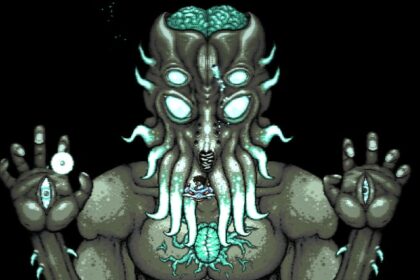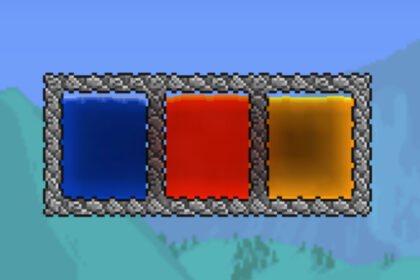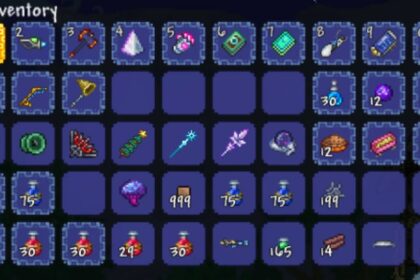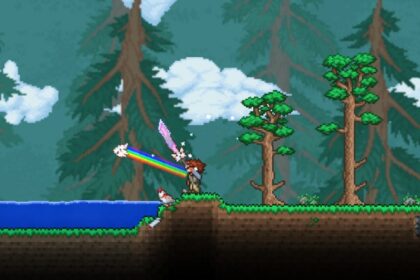There are many biomes in Terraria, each with its own appearance, blocks, enemies, loot, and difficulty. Because of this, each biome is desirable for different reasons.
A common misconception is that biomes can only spawn naturally; this is not the case. In Terraria, some biomes can be made artificially using specific resources and blocks corresponding to the biome you’re making.
This means that there are many different farming and aesthetic possibilities for the biomes that you can create. Due to artificial biomes requiring proper specifications, it’s important to understand how many blocks for a biome in Terraria?
What is a Biome?
Often, the word biome is tossed around with the assumption that everybody understands its meaning. While the true definition of the word biome varies with each game, in Terraria, it has a very loose meaning.
Simply put, a biome is one of the many different areas of your Terraria world – each biome with different characteristics. Because of the lack of clarity on what a biome actually is in Terraria, the areas of the world can be split up into biomes, mini-biomes, micro-biomes, and treasure rooms.
Mini-Biomes
Mini-biomes are small areas of your world that typically have limited size and numbers. They have unique characteristics, including enemy spawns and loot, but usually don’t have different backgrounds or music.
The limited size of mini-biomes means that they aren’t considered full biomes, and each mini-biome can only be found in specific biomes. For example, the Beehive mini-biome is only discoverable in the Underground Jungle biome.

There are eight naturally-occurring mini-biomes and two that can only be artificially created: the Town and the Graveyard.
The Town is a mini-biome that occurs when three or more NPCs are in close proximity to one another. The Graveyard appears around many gravestones clustered together.
Neither of the two artificially-made mini-biomes has any specific block number requirements – only the specifications mentioned.
Micro-Biomes
A micro-biome is similar to a mini-biome in that it has unique structures or tiles. However, they are much smaller than mini-biomes and have no additional exclusive properties.
Some examples of micro-biomes are Gemstone Caves and Flower Patches. Micro-biomes have no size requirement as they cannot be artificially made, though they are generally very small.
Treasure Rooms
Treasure rooms spawn upon world creation but look like man-made structures. Typically, a treasure room contains loot or furniture that is often exclusive to that type of treasure room.
Floating Islands and Living Trees are a couple of the more well-known treasure rooms you will have likely encountered in your game. The loot from treasure rooms can be good early-game but isn’t viable later.

Artificial Biomes
There are some biomes that can be artificially created in Terraria. These are the Forest, Corruption/Crimson, Hallowed, Desert, Jungle, Glowing Mushroom, Meteorite, and Snow biomes.
Each of these biomes has different specifications and block number requirements. Therefore, it’s important to know how many blocks you’ll need for each artificial biome in Terraria.
An artificial biome shares most traits with a natural biome, including enemy spawns. The depth of the created biome will determine whether it’s a surface biome or an underground biome.
Forest
Forest biomes are the default biome in Terraria, and when no other biome requirements are met, the area will be a Forest biome. You can also turn other biomes into Forest biomes.

You can also turn Corruption, Crimson, or Hallowed biomes into Forest using the Clentaminator with Green Solution. This can be useful if you want to avoid fighting the difficult enemies from these biomes.
It’s worth noting that you can recreate these biomes after converting them to Forest by implementing their requirements.
Corruption/Crimson
The presence of evil blocks (Corrupt or Crimson) determines the area’s status as a biome. 300 evil tiles of either Corruption or Crimson (not a mixture) are required to create an evil biome.
Whether the biome is Corruption or Crimson directly corresponds to the type of evil blocks you create. If a plant grows on top of an evil grass block, it will also count towards the 300 evil tiles.
You can create the biome by hand or use a Clentaminator to speed up the process greatly. The solution needed to spread Corruption or Crimson and the purple and red solutions, respectively.
Hallow
Similar to the Corruption and Crimson biomes, the Hallowed biome can also be created with evil blocks. However, unlike these biomes, the Hallowed biome only requires 200 Hallowed tiles to be classified as a biome.
The Hallowed biome can also be spread using a Clentaminator with blue solution. This is a much more efficient way of creating the biome.
If a Hallowed biome is created pre-hardmode, no Hallow-exclusive enemies will spawn: it will spawn Forest enemies instead.
Desert
Desert biomes are arguably the most challenging biome to create. 1000 sand blocks are required to create a proper Desert biome, where the background has become Desert.

The lack of open space in a Terraria world and high block-count requirement can make the Desert biome quite difficult to create.
On top of this, you will need Sandstone or Hardened Sandstone walls if you want to create an underground Desert biome (as well as the 1000 sand block requirement).
Sandstorms and Desert exclusive loot and enemies will both spawn in a proper Desert biome (with the background).
Jungle
The surface Jungle biome is created using Jungle Grass, Hive, or Lihzahrd Bricks on the surface layer of your world. If Jungle Grass is present, Jungle enemies and plants can spawn – regardless of how many Jungle blocks there are.
That being said, to create a full Jungle biome (with the Jungle’s background and music), 140 blocks of Jungle Grass and Lihzahrd Bricks are required. This can include Jungle-exclusive plants.
Worth noting is that Rich Mahogany Trees will naturally grow on Jungle Grass, meaning that Acorns aren’t necessary to obtain Rich Mahogany Wood.
Additionally, sections of placed mud have a chance to turn into Chlorophyte veins. This can only occur in hardmode.
Glowing Mushroom
A minimum of 100 Mushrooms or Mushroom Grass is required to see changes in the background and music of the biome. For the Truffle NPC to appear, making an artificial Glowing Mushroom biome is a necessity.
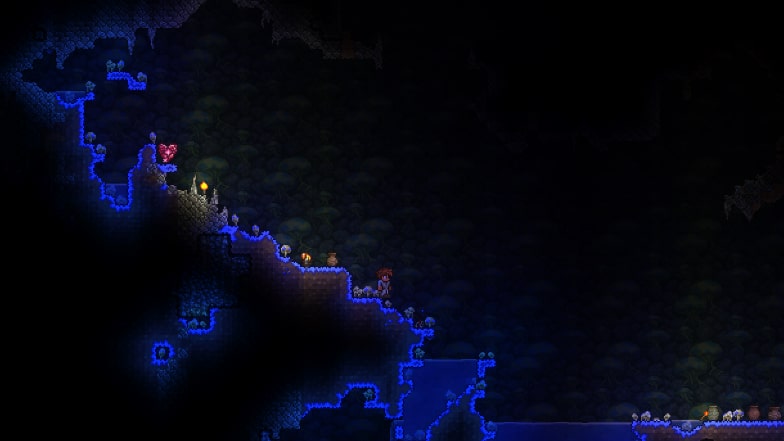
While Glowing Mushroom farms can be much more accessible when made on the surface layer, they won’t spawn Truffle Worms; Truffle Worms can only be found in the underground layer.
You can also create a Glowing Mushroom biome using the Clentaminator with dark blue solution, but it cannot convert dirt, so creating a contained area of the Jungle to convert into a Glowing Mushroom biome is recommended. The Truffle NPC sells dark blue solution.
Meteorite
Creating a Meteorite biome is straightforward. Transforming any biome into a Meteorite biome requires at least 75 Meteorite ore to be on the screen at one time.
This will replace all naturally-spawning enemies with Meteor Heads. This is true for any environment other than the Ocean biome. Unlike any other biome, this also works in the Underworld (otherwise known as Hell).
Snow
To create a Snow biome, at least 1500 blocks of Snow, Ice or Snow Bricks are required. Snow biomes are particularly unusual because the spawning of some enemies depends on different conditions.
These conditions are the presence of ice blocks, biome depth, and whether or not it’s raining/snowing. Additionally, below the cavern layer, the environment will be considered an Ice biome rather than a Snow biome.
Conclusion
There are many different biomes in Terraria – some of these can be made artificially. The artificial biomes have different block requirements to be considered a biome.

